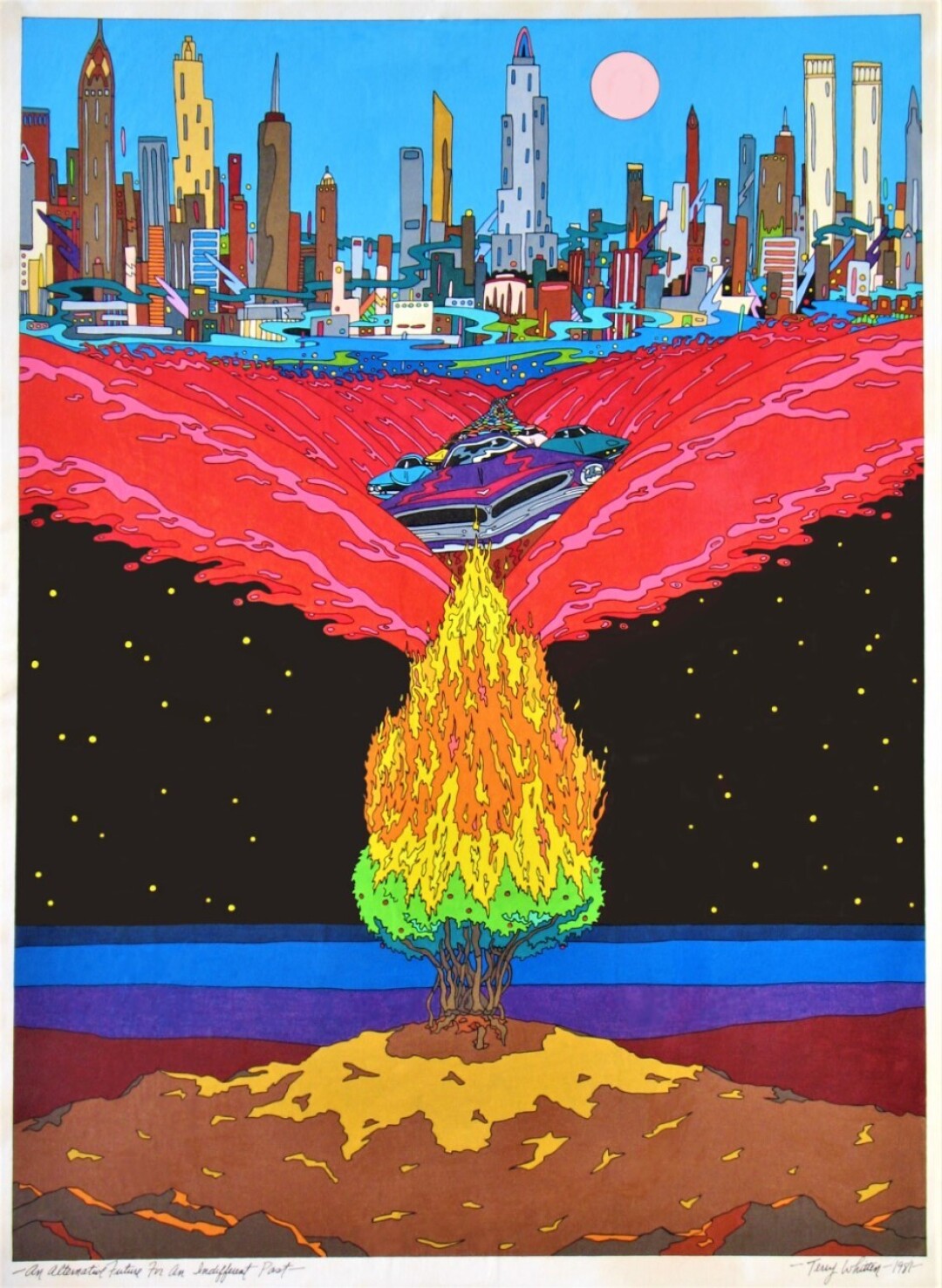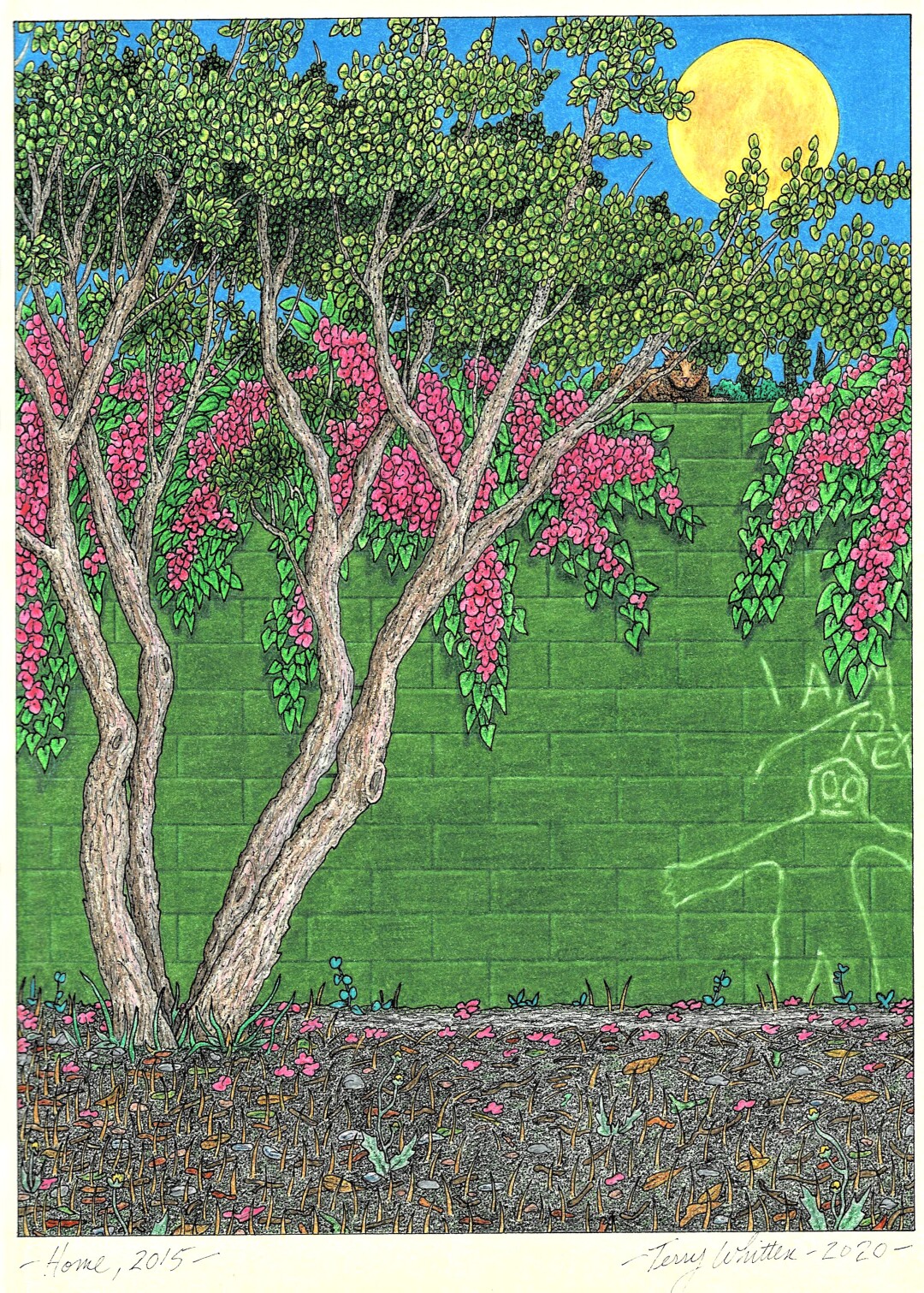The trip from his new apartment in Glassell Park to his post office box in Hollywood may have been mostly tedium. But on this day, Terrance Whitten looked forward to one glorious moment.
As the Metro 780 bus climbed away from the L.A. River past the handsome facades and proud deodars of Los Feliz Boulevard, then turned south on Vermont Avenue, his anticipation peaked.
Just past Skylight Books, on an electrical utility box, theretofore a drab platform for handbills and graffiti, he would see his vision — a fanciful interpretation of the Griffith Observatory framed by a comet in a starry sky and a bed of yellow, orange, blue and pink flowers.

It was his gift to Los Angeles, an artist’s public affirmation of his deliverance from a series of misfortunes that had left him living under a tree in Pan Pacific Park.
How that image got on that utility box is a tale of two strangers who were drawn together by a newspaper article, collaborated for months without once meeting in person and beat down every barrier of bureaucracy and bad luck that would have blocked their plan.
Mark Pampanin, then the young communications director for former Los Angeles City Councilman David Ryu, learned of Whitten through a Times report on his protracted journey out of homelessness. The story, published last July, was primarily an account of the bureaucratic inefficiency that kept Whitten languishing in the park for weeks after a vacant apartment had been set aside for him.
But Pampanin was smitten by several colored-pencil drawings published with the article as examples of the artist’s work in earlier times,when circumstances allowed him to be productive.

He mentioned it at a staff meeting, and all agreed that Whitten’s work was a good fit for the council office’s program to beautify the tall metal boxes that contain the electronic controls for traffic signals.
Usually artists petition the council office for permission to take part in the popular program, but Pampanin saw no reason the office couldn’t petition the artist.
With The Times as intermediary, Pampanin tentatively approached Whitten to test his interest. The recently homeless artist was ready for the challenge.
Quickly warming to his new one-bedroom apartment, he had placed his bed in the sitting room next to the kitchen, turned the bedroom into a studio and gone to work. He restarted a series on Hollywood landmarks, suspended more than a decade before, when his life became chaotic. And he turned his eye to his new environs in northeastern L.A., drawing an equestrian bridge over the L.A. River and a street scene on El Paso Drive.

But there was a hitch in Pampanin’s plan — the first of many to come. Whitten didn’t paint, at least not like he might have 20 years earlier, before a debilitating back injury. His vivid and delicate images were made of colored pencil on paper, a medium not readily transferable to a 5-foot steel panel.
Pampanin improvised a solution. He knew a company downtown that produces the large, vinyl advertisements that are applied to cars and buses. If Whitten would draw four panels to scale for the four sides of the box, Pampanin would have the images transferred to self-adhering sheets.
He picked a utility box on Los Feliz near Vermont. The proximity to Griffith Park, and Whitten’s enduring fascination with L.A. landmarks, made the observatory an obvious subject.

Whitten initially drew in black pencil for the next step — submission for review by the city Department of Transportation.
Though no authority on art, the DOT has an interest in what appears on its utility boxes: no advertising, electioneering or racist, pornographic or violent imagery. For obvious reasons, it also prohibits reflective materials or symbols that mimic traffic signs.
In the case of Pampanin’s plan, there were less obvious considerations. The vinyl sheets could not cover or obstruct cabinet air vents, door handles, key holes, hinges or seams.
It turned out that the DOT also wanted to see the colors. Whitten redrew and resubmitted his drawings in color. By the time they passed DOT review, weeks had passed.
Then came trouble with the reproduction. Upon scanning the pencil images, Whitten discovered that the wax emulsion in his pencils refracted the colors into tiny shards that would grow into fatal defects in an enlargement. He spent three days on Photoshop going over all the color with the blurring tool. The result was something new for him, a hybrid medium of paper to digital to plastic.

By then, the project had extended into a period of anxiety and distraction for the communications director of an elected official: campaign season.
As Ryu battled a well-organized challenge by community activist Nithya Ramen, Pampanin lost his focus on Whitten and the utility box.
Then came defeat and the week in mid-December when Ryu’s staff had to clear out their desks. With no time left to deliver on his promise, Pampanin had a reckoning.
“I couldn’t be like, ‘Well we lost, so we’re not going to finish it.’ ” he said. “I wasn’t just going to walk away.”
He sent an apologetic email to Whitten: “I’ll get it done. I promise.”
He picked up the vinyl, putting the nearly $300 bill on his credit card, and appealed to his colleagues for help.

“I tried to pitch it like ‘This is going to be our final hurrah,’” he said.
Pampanin and office mates Rachel Fox and Natalie Pineda gathered at the designated power box Dec. 12 and worked six hours scraping off peeling paint and handbills. Exhausted, they decided to come back the next day to apply the vinyl with fresh eyes.
When they returned, the street side of the box was papered over with a large print depicting several bluish human forms. Was it art or vandalism?
Searching online, Pampanin identified the renegade artist as Evan Mendel, who had posted a video of himself applying his work of Figurative Expressionism that, he said, uses “the human subject along with color to express emotion.”
“Well, we’re not going to take this down,” Pampanin decided.

After the holidays, Fox, who had a permanent job in the council office, found another box a few blocks south on Vermont, from which the real observatory was visible. The project stalled one more time when Pampanin’s car ended up in the shop for two weeks. He had forgotten the vinyl in the trunk.
Finally, on Jan. 31, a day after Whitten’s birthday, Pampanin and colleagues spent another day scraping and applied the vinyl immediately, before anyone else could intervene.
It wasn’t perfect. Pampanin had to cut a hole in the vinyl for the handle, and one panel was a little askew.
“I’m not a professional,” he would explain.
Whitten came a few days later to take care of the final details. He trimmed the crooked border and painted the exposed portions of the box, including the handle, in vivid blue, matching the night sky in the drawing.
“It made it look like a lantern,” he said. “It looked really nice.”
The moment that would have been his coda — seeing his observatory artwork as part of L.A.'s most attractive quarters — would come four days later, when he took the bus to pick up his mail.
As the Metro 780 bus climbed away from the L.A. River past the handsome facades and proud deodars of Los Feliz Boulevard, then turned south on Vermont Avenue, his anticipation peaked....

The utility box came into view. But his drawing was gone.
Whether by vandalism or by theft, the vinyl had been stripped away, leaving just the bare and graffitied surface of a metal box.
The emotional blow was so severe that Whitten couldn’t bring himself to go back.
“Certainly not at the scene of the crime,” he wrote in reply to an email from The Times requesting he meet there for a photograph. “The vicious act has stained for me one of my favorite stretches of street in L.A.”
After resisting for weeks while waiting to complete his COVID-19 vaccinations, Whitten finally agreed in mid-March to recount the story in the safe surroundings of his studio, with his new feline companions Charlotte and Emily nearby.
It was a touching first meeting between Pampanin, the 28-year-old patron, and the 68-year-old artist. For 90 minutes they commiserated over the enterprise that began with such high expectations and ended in so much pain.
Pampanin, who now works for the mayor’s civil rights division, received a private showing of Whitten’s lifework, from the early portraits of Marilyn Monroe and Elvis Presley to the Temple Mount in Jerusalem, with black and green olives in the foreground.

Saved for last was his “Hollywood Gourmet” series, drawings of landmarks such as Musso & Frank Grill, Paramount Studios and Rudolph Valentino’s crypt, each paired with a whimsical food motif. Since gaining a home, Whitten had added six drawings to the eight he had completed in 2008.
Pampanin responded to the blend of reverence and whimsy.
“It’s such a beautiful portrait of L.A.,” he said. “I’m not versed in art enough to say why I love these, but I love these.”
A note of regret held back the obvious question: Should they do it again? Pampanin said he doesn’t expect to be reimbursed for his expenses, and Whitten said he never received the stipend that Ryu’s office customarily paid utility box artists.
As a parting gift, Whitten offered Pampanin a drawing from his repository.

“Don’t waste your money on a frame,” he advised. “Invest in the mat.”
Pampanin said he hoped he would next see Whitten at an exhibit of his “Hollywood Gourmet” series.
Whitten said he hoped so, too. But there might be a few hitches. First, he’ll have to do 10 more drawings to complete the 24 he envisioned for the series.
Then he’ll need to frame them — using just the right matting.
"artist" - Google News
April 04, 2021 at 07:00PM
https://ift.tt/2PW1ZJe
A formerly homeless artist made a gift to Los Angeles. What happened next was a surprise - Los Angeles Times
"artist" - Google News
https://ift.tt/2FwLdIu
Bagikan Berita Ini















0 Response to "A formerly homeless artist made a gift to Los Angeles. What happened next was a surprise - Los Angeles Times"
Post a Comment